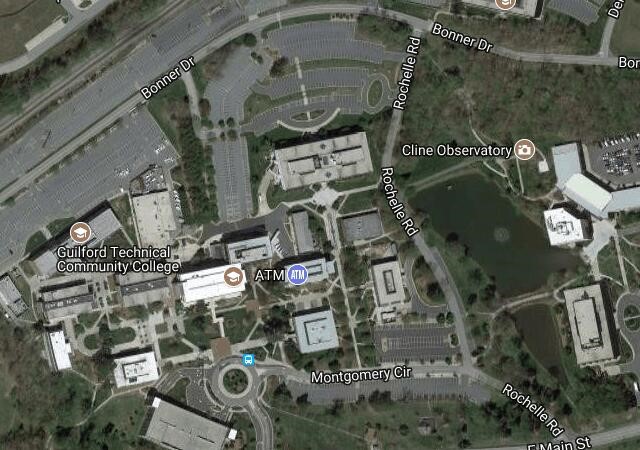Solar System Walk
Explore the Solar System by Walking Our Campus
Laid out from Cline Observatory to near the west end of campus are models of the sun and planets, with all sizes and distances scaled down from their true values by a factor of about 10 billion. We call this our Solar System Walk, and you can walk along its path to learn about the many planets and objects that make up our solar system.
In August 2006, the International Astronomical Union (IAU) established three criteria to define an object as a planet in our solar system:
- it must be a natural body orbiting the sun,
- it must have strong enough self-gravity to deform itself into a round shape, and
- its gravity must be strong enough that it is the dominant object in its region of space.
Under these rules, we have eight planets in our solar system: Mercury, Venus, Earth, Mars, Jupiter, Saturn, Uranus, and Neptune. Each of these, along with the sun, is represented in the GTCC Sidewalk Solar System. Objects that satisfy criteria 1 & 2, but not 3, are classified as dwarf planets.
Also included in our model are representatives of two populations of smaller bodies in our solar system: the main belt of rocky asteroids between Mars and Jupiter, with Ceres as the representative object, and the icy asteroids of the Kuiper belt, which move in orbits beyond Neptune. Pluto is the highlighted object in this group. Both Ceres and Pluto are dwarf planets in the IAU classification.

Solar System Walk
View Solar System Walk in a larger map
In addition to a correctly scaled rendering of the featured object, each planet’s station includes general information about the object and a couple of photos. Most of the photos were taken by spacecraft that were either orbiting the object or passing by at close range.
Perhaps the most surprising thing to be learned from this scale model is how very small the planets are compared to the distances between them. Standard “family portraits” of the solar system that depict the planets lined up virtually end-to-end do not convey a true sense of how empty space really is. This emptiness is even more profound for interstellar distances. On the scale of this model, with the Earth about 15 meters from the Sun, the next-closest star would be over 3000 kilometers away, in northern Arizona!
One common misconception about the solar system is that the planets are all laid out in a straight line from the Sun. In fact, they all orbit the Sun at different rates, so a perfect linear alignment almost never occurs. While this static model cannot display the current locations of the planets in their orbits, it does illustrate the scaled-down distance covered in one day by each object as it travels around the Sun.
Please enjoy your tour!
Tour Information
At each station, you will find the following information:
- A description of the astronomical object and its major features.
- A table indicating basic physical and orbital properties.
- Assorted images of the object and related features or satellites.
- A dot indicating the size of the object to scale.
- An arrow indicating the distance the object moves along its orbit in one day.
- For planets that have major moons, a scaled depiction of the orbits of these satellites.
Credits
We would like to thank the following for making this project possible.
- Aaron and Ruth Martin, for their vision and support.
- President Donald W. Cameron, for his continued support of the project.
- Phi Theta Kappa Honor Society, especially past presidents Bill Skislak and Ridwan Othman, and advisor Beverley Gass, for their efforts to make this project a reality.
- The Surveying Technology Program at GTCC, whose students helped us pinpoint the locations for our stations.
- The GTCC Foundation, especially Margot Horney, for their assistance in all aspects of this project.
- The Cline Observatory Advisory Committee, for guidance and advice.
- Cheryl Hemric, for converting our ideas for content into the design of the displays in our stations.
- Robert Meyer and his groundskeeping crew at GTCC, for installing and maintaining the pavers and posts at each station.
- Margaret Reid of the Graphic Arts department at GTCC, for her assistance in our early efforts to design our content.
- Display text by David Herrick, GTCC astronomy Instructor.
- This project was managed by Observatory Director Tom English.
- Images courtesy NASA/JPL-Caltech – Solar eclipse image by Aaron Martin.
